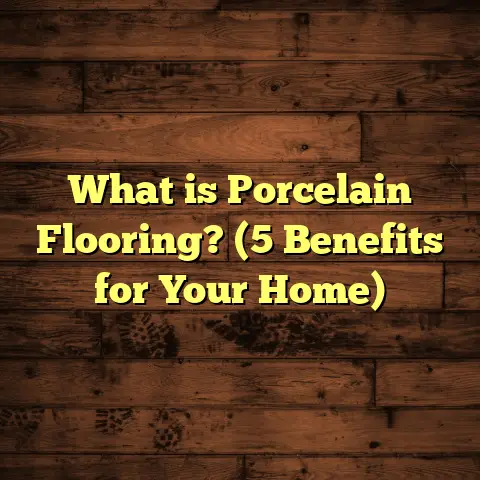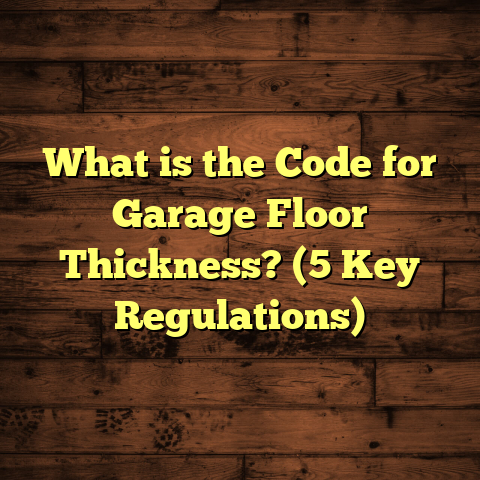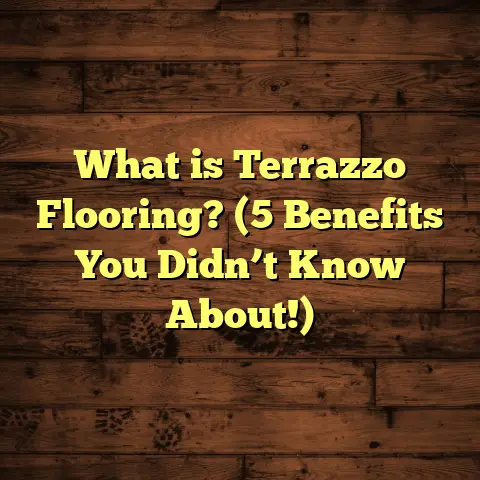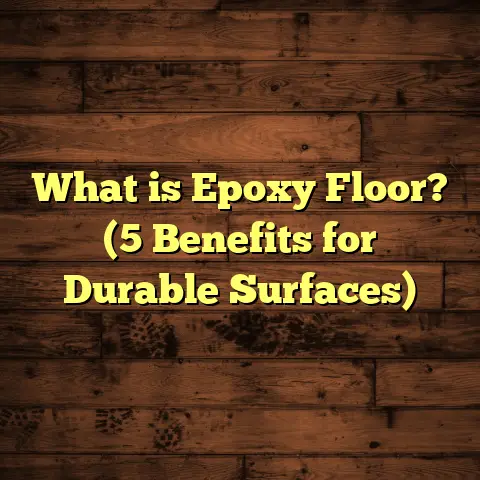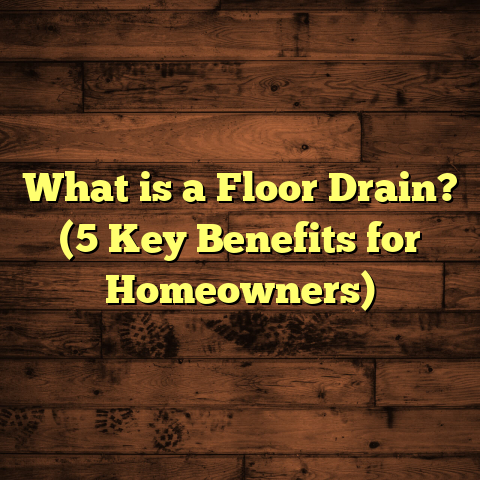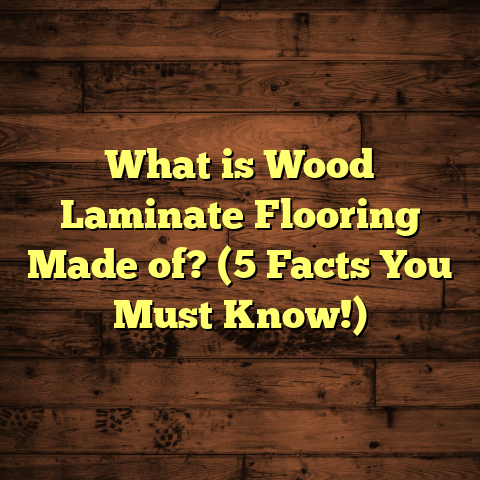What is Woodblock Flooring? (5 Benefits of a Timeless Choice)
What is Woodblock Flooring?
You know how your home’s floor can set the whole vibe of a space? I’ve always felt that flooring is like the unsung hero of interior design — it holds everything together, literally and visually. When I first got into flooring, I mostly worked with hardwood planks and laminate. But woodblock flooring? That’s a different story. It’s like a classic novel in a world of fast-paced ebooks. It has history, texture, and a kind of personality that just can’t be faked.
Let me break it down simply: woodblock flooring is composed of small blocks or strips of solid wood that are arranged in patterns and glued directly to the subfloor. Unlike traditional long hardwood planks, these blocks are typically square or rectangular. They’re installed in repeating geometric patterns — think herringbone, basketweave, or checkerboard.
The result? A surface that’s not only beautiful but incredibly tough. This style has been around for centuries, originally popular in European architecture. It was often used in grand homes, public buildings, and even churches. Today, woodblock flooring is making a comeback because it combines durability, aesthetics, and sustainability.
In my years installing and restoring floors, I’ve come to appreciate how woodblock flooring can transform a space, giving it both warmth and character that lasts for decades.
The Lifestyle Connection: Why Floors Matter More Than You Think
Before we get deeper into the nuts and bolts of woodblock flooring, let’s chat about why this matters for you.
Have you ever walked into a room and immediately felt something? Maybe the floor was cold and sterile like in some offices or too worn down to be comfortable. Or maybe it was warm, inviting, and full of life like an old family home. That feeling comes a lot from the floor beneath your feet.
For families with kids running around or pets scratching floors, durability is key. For those who work from home or entertain guests often, style and comfort become priorities. And if sustainability is high on your list, knowing your floor isn’t contributing to deforestation means a lot.
Woodblock flooring ticks many lifestyle boxes:
- Durability for active homes
- Timeless style for those who want classic over trendy
- Sustainability for eco-conscious living
- Easy maintenance when life gets busy
I’ve installed woodblock floors in homes where kids grow up barefoot running through rooms and in offices where people walk hundreds of steps daily. It holds up well every time.
How Is Woodblock Flooring Made?
It’s easy to confuse woodblock flooring with parquet flooring — they’re related but not exactly the same. Parquet refers broadly to patterned wood floors made from small pieces of wood fitted together. Woodblock flooring specifically refers to blocks of solid hardwood laid in patterns glued directly to the subfloor.
The blocks themselves are usually cut from hardwood species like oak, maple, cherry, or walnut. These woods are chosen because they’re dense and resistant to wear.
Manufacturing Process
- Selection of Timber: High-quality hardwood logs are selected.
- Cutting Blocks: Logs are sawn into smaller blocks or strips, usually 20–25 mm thick.
- Drying: The wood is carefully dried to prevent warping.
- Sanding & Finishing: Blocks are sanded smooth; sometimes pre-finished.
- Packaging: Blocks are bundled ready for installation.
The precision in cutting uniform blocks is critical because the entire pattern depends on tight fits between pieces.
Benefit #1: Durability That Stands the Test of Time
One thing I’ve noticed firsthand is that woodblock floors are built to last. When installed correctly, they’re incredibly hard-wearing.
How Durable Are We Talking?
- Typical hardwood planks last 20-30 years under regular use.
- Woodblock flooring can last 50 years or more.
- Thickness ranges from 20 to 25 mm (vs. 14mm for many hardwood planks).
- Blocks are glued down solidly, meaning less movement and less chance of squeaking or warping.
Durability means a lot if you have kids racing around or pets with claws like mine. I remember installing a woodblock floor in a busy café where foot traffic was constant — after 15 years it still looked great.
Real-World Data
According to studies by the National Wood Flooring Association (NWFA), solid woodblocks show superior resistance to indentation compared to engineered hardwoods and laminates. This is because the mass of solid wood absorbs impact better when glued down securely.
Benefit #2: Unique Patterns Add Personality
Woodblock flooring isn’t just about durability — it’s also about style that grabs attention without screaming for it.
Endless Design Possibilities
Patterns possible include:
- Herringbone: Zigzag pattern creating dynamic movement.
- Basket Weave: Blocks arranged in pairs alternating vertically and horizontally.
- Checkerboard: Classic squares alternating wood grains or stains.
- Diamond: Diagonal squares creating an elegant look.
- Custom geometric patterns: For those who want something truly unique.
I once helped a client design a custom star pattern using contrasting woods. The result was jaw-dropping—people kept asking who designed their floor!
Why Patterns Matter
Patterns aren’t just pretty; they influence how space feels and flows. A herringbone pattern can make a narrow room feel longer; checkerboard adds playful sophistication to kitchens or dining rooms.
Benefit #3: Sustainability Matters Here
More people ask me now about eco-friendly flooring options. Woodblock flooring fits well because:
- It uses smaller pieces of wood efficiently — less waste than cutting wide planks.
- Many suppliers source timber responsibly; some even use reclaimed wood.
- Solid wood is biodegradable at end of life — unlike synthetic options.
The Forest Stewardship Council (FSC) certifies many woodblocks ensuring they come from responsibly managed forests. Choosing FSC-certified blocks helps preserve our forests while enjoying authentic materials.
I had a client who insisted on FSC-certified oak for their floor because their family values environmental responsibility deeply.
Benefit #4: Maintenance Made Simple
A big question I get: “How hard is it to keep woodblock flooring looking good?”
Short answer? Not hard at all.
Cleaning Tips That Work
- Sweep or vacuum regularly to keep grit off the surface.
- Mop occasionally with a damp mop or cloth (avoid soaking).
- Use floor cleaners made for hardwood specifically.
- Avoid harsh chemicals that damage finishes.
Dealing with Wear and Tear
Scratches will happen — natural for any wood floor. But here’s the good part: you can sand and refinish woodblock floors several times over their lifespan without replacing them.
One family I worked with had dogs who scratched their floor badly within 5 years. After refinishing twice over the next decade, the floor looked almost new again.
Maintenance is about consistent care rather than expensive fixes.
Benefit #5: Boost Your Home’s Value and Appeal
If you’re thinking about resale value or just making your home more welcoming, woodblock flooring delivers on both fronts.
Real Estate Insights
Homes with original or well-maintained solid wood floors often sell faster and at higher prices than those without. It’s something buyers notice subconsciously — quality floors add perceived value.
For example:
- A 2022 National Association of Realtors survey found homes with hardwood floors sell for about 2-5% more on average.
- Woodblock floors stand out because they’re rare compared to standard hardwood planks.
I’ve seen clients recoup their investment many times over after installing woodblocks when selling older homes.
How Woodblock Flooring Changed My Approach as a Contractor
When I started out, laminate and engineered hardwood were my go-to floors because they were cheaper upfront and quicker to install. But projects involving woodblock floors opened my eyes.
One standout job was restoring an 1880s Victorian home whose original woodblock floors were covered in paint layers and grime. Removing those layers took patience and elbow grease but revealed stunning craftsmanship below.
After refinishing, the home transformed completely — warmer light reflected off the blocks, adding depth to every room.
That experience made me realize that sometimes traditional methods offer more long-term satisfaction than faster modern alternatives.
Installation Basics: What Sets Woodblock Flooring Apart?
Installing these floors isn’t like clicking together planks or rolling out vinyl sheets. Here’s what you need to know:
Step-by-Step Installation
- Subfloor Preparation: The subfloor must be clean, flat, and dry — usually concrete or plywood.
- Adhesive Application: A strong adhesive is spread evenly over the subfloor.
- Block Placement: Each block is placed individually by hand following the chosen pattern.
- Alignment Checks: Blocks must be precisely aligned for pattern consistency.
- Drying Time: Adhesive cures over 24–48 hours before sanding.
- Sanding & Finishing: The entire floor is sanded smooth; finishes like varnish or oil are applied last.
Why It Takes Time
Because each block is glued separately, installation requires patience and skill — rushing leads to gaps or uneven surfaces.
I’ve found that accurate estimates upfront are crucial since labor hours can vary widely depending on pattern complexity and room size.
How I Use FloorTally to Manage Costs Effectively
Budgeting can be tricky with woodblock flooring due to variables:
- Pattern complexity (more intricate = more waste).
- Wood species selected (exotic woods cost more).
- Labor rates in your area.
- Finishing choices (some finishes cost extra).
I rely on FloorTally for quick, accurate estimates during project planning. It factors in local material prices plus labor costs based on regional averages. By inputting room size, pattern type, waste factor (usually around 10–15% for patterned blocks), and finish preferences, I get reliable cost projections within minutes.
This helps me communicate realistic budgets with clients upfront so no surprises come later.
Comparing Woodblock Flooring With Other Popular Options
Here’s some data from recent projects that might help you decide:
| Flooring Type | Average Lifespan | Cost per Sq Ft (Material + Installation) | Maintenance Frequency | Refinishing Ability |
|---|---|---|---|---|
| Woodblock Flooring | 50+ years | $12 – $18 | Every 7–10 years | Multiple times possible |
| Engineered Hardwood | 20–30 years | $8 – $14 | Every 5–7 years | Limited |
| Laminate Flooring | 10–20 years | $3 – $7 | Minimal | None |
| Vinyl Flooring | 10–15 years | $2 – $6 | Minimal | None |
These numbers can shift by region but give you an idea of long-term value versus upfront cost.
Case Study: Restoring a Century-Old Gem With Woodblock Floors
A recent project that stands out was a century-old bungalow with original oak woodblocks showing signs of water damage and heavy wear.
Most experts suggested tearing out everything and installing engineered hardwood planks for speed — but I proposed restoring the existing blocks instead.
Here’s what we did:
- Removed damaged sections carefully.
- Sourced matching reclaimed oak blocks for replacement.
- Cleaned and sanded the entire floor.
- Applied multiple coats of water-based polyurethane finish.
The floor came back to life — better than new in some ways — preserving the home’s authenticity while saving thousands compared to full replacement costs.
The homeowner was thrilled with how much character the restored floor added to their living space.
Choosing the Right Wood Species for Your Woodblock Floor
Not all woods perform equally. Here’s what I typically recommend based on durability and aesthetics:
| Wood Species | Hardness (Janka Rating) | Appearance | Cost Range per Sq Ft |
|---|---|---|---|
| Oak | 1290 | Classic grain; light to medium brown | Moderate |
| Maple | 1450 | Fine grain; creamy white | Moderate |
| Cherry | 950 | Reddish hue; ages beautifully | Higher |
| Walnut | 1010 | Dark rich color | Higher |
| Hickory | 1820 | Varied grain; very hard | Moderate |
Hardness impacts scratch resistance—higher Janka means tougher wood but sometimes harder to sand.
Choosing the right species depends on your style preference and how much wear you expect on the floor.
How Environment Affects Woodblock Flooring Longevity
Wood reacts to moisture and temperature changes by expanding or contracting. This can lead to gaps between blocks or buckling if conditions fluctuate wildly.
To prevent problems:
- Maintain indoor humidity between 35%–55%.
- Use humidifiers/dehumidifiers as needed.
- Avoid flooding or standing water near floors.
- Ensure proper subfloor moisture barriers during installation.
I recommend clients invest in quality HVAC systems that regulate humidity year-round if they want their floors looking perfect for decades.
Personal Tips From Years on the Job
Here are some practical pointers based on what I’ve learned:
- Don’t rush installation: Precision matters more than speed with patterned blocks.
- Consider underfloor heating carefully: Woodblock flooring works with radiant heat but requires professional installation.
- Protect floors from heavy furniture: Use felt pads under legs.
- Avoid rubber-backed mats: They can trap moisture and discolor finishes.
- Schedule regular inspections: Catch minor damage early before it spreads.
What About Cost? Let’s Get Real
Woodblock flooring tends to be pricier upfront than laminate or vinyl due to labor intensity and quality materials.
Typical costs:
- Material: $8–$12 per sq ft (varies by species)
- Installation: $4–$6 per sq ft (pattern complexity impacts this)
- Finishing: $1–$3 per sq ft depending on finish type
For a 1,000 sq ft room, expect $12,000–$18,000 total investment roughly.
That sounds steep if you’re used to cheaper options but remember: this floor lasts decades longer than laminate or vinyl you’d replace every 10 years.
Using tools like FloorTally helped me map out these costs clearly for clients so they understand where money goes—materials vs labor vs finishing—and plan accordingly without surprises later on.
Final Thoughts: Is Woodblock Flooring Right For You?
If you value craftsmanship, durability, style versatility, and sustainability—woodblock flooring offers a compelling package.
It’s not the cheapest option upfront but pays dividends over time through longevity and timeless appeal.
I love helping homeowners rediscover this classic choice because it connects us back to tradition while meeting modern needs beautifully.
Got questions about patterns? Installation? Budgeting? Just ask—I’m happy to share what I’ve learned working hands-on with this incredible flooring type over many years!
Would you like me to help you explore specific patterns or walk through installation steps in more detail? Or maybe share stories from other projects? Let me know!
